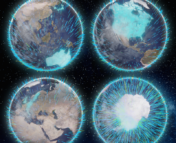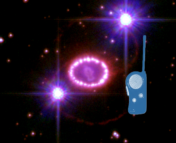Title: Galactic Diffuse Neutrino Emission from Sources beyond the Discovery Horizon
Authors: Antonio Ambrosone, Kathrine Mørch Groth, Enrico Peretti, and Markus Ahlers
First Author’s Institution: Dipartimento di Fisica “Ettore Pancini”, Universita` degli studi di Napoli “Federico II”
Status: Published in PRD [closed access]
Astrophysical neutrinos (a.k.a. ν) are particles that are really hard to detect but serve as a treasure map to uncovering a key mystery of the high energy universe: where cosmic rays are coming from. Cosmic rays typically refer to charged particles (usually protons or nuclei) that zoom through the universe at nearly the speed of light but get split off from their paths in all directions due to magnetic fields in the Milky Way and beyond. To find where cosmic rays are coming from, we need to trace the paths of neutral particles (that aren’t affected by magnetic fields) produced in interactions between cosmic rays and the material around them, like gamma-ray photons and neutrinos.
Some IceCubes in your Milk[y Way]?
Recently, the IceCube neutrino observatory announced the first detection of high energy neutrinos coming from the Milky Way’s Galactic plane (see this bite and Figure 1). IceCube is a huge neutrino detector at the South Pole that uses long strings of optical detectors to look for the Cherenkov radiation that particles give off when they interact in the Antarctic ice. Neutrinos rarely interact with anything, but they occasionally interact with the ice to make leptons (electrons, taus, or muons; IceCube is most sensitive to muons), which will then produce Cherenkov radiation. The tracks of light left by an individual particle are called “events”.
IceCube usually looks up from the South Pole at neutrinos coming from the Northern hemisphere. The Earth serves as a filter, letting high energy leptons produced by astrophysical neutrinos through, but blocks lower energy muons produced in the atmosphere that often mimic neutrino signals. However, the Galactic plane is located mostly in the Southern hemisphere, so IceCube has a lot of junk particles contaminating the detector and it’s almost impossible to pick out which events are actually from astrophysical neutrinos.
IceCube broadly detects two types of events: track events where the particle interacts outside the detector and leaves a track as it travels through the detector, which can be easily traced back to where the neutrino came from in the sky, and cascade events where the particle interacts within the detector and moves out in a spherical pattern. For any events coming from the Southern sky, we don’t have the Earth to block out muons, so track events are hard to tell apart from muons from the atmosphere. Cascade events, on the other hand, are relatively pure neutrino signals, but the particle’s path can’t be traced back easily to its source. This leads to a huge uncertainty in the location where we think the neutrino came from – leading to the blobby structure of neutrinos compared to the high-resolution maps of photons seen in Figure 1.
To diffuse or not to diffuse
Today’s authors look at the possible origin of these Galactic plane neutrinos and how IceCube’s instrumental limitations may result in the blobby image of the Galactic plane. The current theory is that these blobs are diffuse neutrino emission coming from cosmic rays crashing into the interstellar medium (ISM), which is thicker in the Galactic plane. However, today’s authors postulate that because IceCube can’t see a lot of detail in the Galactic plane, they might be coming from individual high energy sources that IceCube just can’t see very well.
IceCube’s angular resolution – i.e., the smallest detail it can see – is 7 degrees. For reference, the size of the Moon as seen from Earth is only half a degree – so any individual point in the IceCube sky is fourteen times the size of the moon! Poor angular resolution smushes together individual sources into blobs, making it impossible to tell them apart (sort of like when you need a new prescription for your glasses!). On top of this, IceCube can only see objects that are fairly bright in neutrins, and just like with optical light, the further away a source is, the dimmer it’ll be. With these constraints in mind, the authors made a map of the Milky Way, shown in Figure 2, which gives IceCube’s horizon, or the maximum distance it can see neutrinos from in any direction in the Milky Way.
Are you feeling energized?
The authors look at both diffuse emission and known astrophysical sources in the Galaxy to see how well they match the neutrinos that IceCube observed from the Galactic plane. Luckily the observations give us an interesting clue about the neutrinos – IceCube sees neutrinos up to really high energies (100 TeV – i.e., ~10 times the energies of particles accelerated in the LHC!), which limits the types of sources that are energetic enough to make them.
Today’s authors find that the diffuse neutrino emission caused by cosmic rays crashing into the ISM probably isn’t the only source of neutrinos in the Galactic plane. There’s likely something (or many things) out there producing the highest energy neutrinos. To see what’s able to produce this neutrino flux, the authors turn to other potential sources of cosmic rays: pulsar wind nebulae (big high energy emission regions made by pulsars injecting particles into their surroundings), young massive star clusters that accelerate cosmic rays in stellar winds, and supernova remnants.
The authors find that all three types of sources are powerful particle accelerators that are capable of producing the highest energy neutrinos seen by IceCube. Right now, IceCube’s images are too blobby to disentangle them from each other or the diffuse emission that comes from the Galactic plane. The mystery of the Milky Way’s neutrinos will need to stay unsolved a little bit longer until a detector comes along that is able to resolve any individual sources. The next generation of neutrino observatories, including KM3NeT and IceCube-Gen2 may be able to look further into the Galactic plane with better eyesight and hopefully be able to untangle some individual neutrino-making sources from the blobs that IceCube sees!
Astrobite edited by Katherine Lee
Featured image credit: iStock




